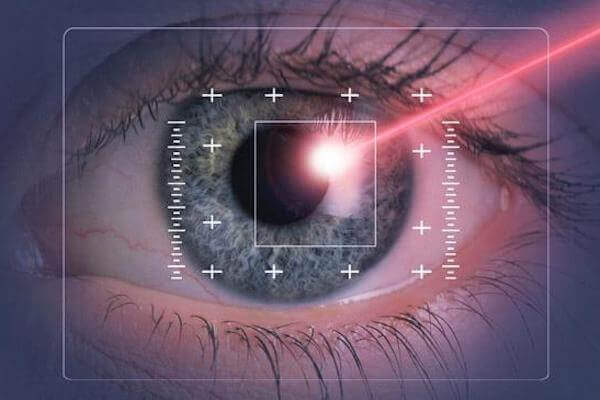Telephone and e-consultation are available when sought. Contact Us to arrange.
Telephone and e-consultation are available when sought. Contact Us to arrange.

Laser Eye Surgery is when lasers are used in corrective eye surgery to correct/minimise dependence on glasses for sight.
Highly specialised lasers are applied to the front dome of the eye called the cornea to re-shape it such that light passing through the modified cornea will be focussed accurately as it passes into the eye.
Laser surgery can be used to treat a wide range of focusing errors including myopia, hyperopia and astigmatism.
It is generally used in the under 40s seeking glasses corrective surgery.
For the over 40s:
Three techniques are available:
In LASIK 2 types of laser are used. The first is called a Femtosecond laser and is used to create a thin precise flap. The second Laser called an Excimer laser is then used to precisely reshape the corneal bed underneath to treat the desired prescription. The flap layer will then be repositioned to cover the treatment area



In LASEK there is NO flap. A thin layer of surface cells are loosened using a special alcohol and the Excimer laser is then used to precisely reshape the corneal bed underneath to treat the desired prescription. A dissolvable artificial contact lens is then put over the treatment area which helps a new surface layer of cells to form to replace the layer removed with the special alcohol
In SMILE only the femtosecond laser is used. A thin sliver (called lenticule) of cornea is created by the laser to the shape which corresponds to the desired prescription that needs to be treated. This is lenticule is created within the layers of the cornea. Through a small pocket (also created by the same laser) the lenticule is then carefully extracted to achieve the desired treatment effect.

A thin lenticule, a lens shaped plece of corneal tissues, and small incision are created Inside the intact cornea.

The lenticute is removed through the incision with minimal disruption to the cornea.

Removing the lenticute changes the shape of the cornea, thereby achieving a refractive correction
LASIK – allows for very fast and comfortable healing.
LASEK – allows for for keeping the eye structure stronger after treatment (essential in patients with higher prescriptions or with thinner cornea), and also causes less post laser dryness of the eyes.
SMILE – allows for fast healing, comfortable recovery, keeping the eye stronger, and less dryness.
Following detailed assessments and checks to confirm safety parameters, the treatment is undertaken. The whole treatment usually takes between 20 to 30 minutes. The actual treatment laser is in operation for only a tiny fraction of this time (seconds). Surgery is performed with drops anaesthesia and is painless for patients. After a quick post operative check by the surgeon, patients are free to go with drops to facilitate effective healing.
Regular follow up checks are undertaken to confirm appropriate healing.
Within a few days patients will notice being able to see very well without glasses. The different techniques all achieve the same end result of good vision without glasses.
As with all forms of surgical treatments there are risks of unpredictable outcomes and complications. As a general rule of thumb patients can expect a 95% chance of achieving functional vision to a high standard (corresponding to their best vision potential) from their initial surgery. 1-5% of patients may have some difficulties but in the majority of cases these can be managed. The risk of severe and lasting problems is very low at 1:2000 or less per eye (so both eyes getting affected is very rare indeed).
Click here to see detailed price list for all consultations and procedures
We offer a comprehensive eye service delivered through specialist and generalist eye doctors.
Please click here to read on all our speciality procedures
Please note: Whilst these are the general suitability criteria, individual criteria has to be taken into account for specific patient needs and the appropriate procedure applicable.
We are not a cut-price service because quality does not come by making compromises. However we are competitive and transparent in our pricing structure. We make efforts to ensure that patients are made aware of all price points in advance of any consultations/investigations and procedures, to enable our patients to make an informed choice on how they would like to proceed. Read more on the details of our prices
We work with all insurers. Please refer to the above FAQ on “Pricing” for full details. Please note – even if your insurer is not on the list of companies provided, let us know and we can help to make arrangements. Read more on the insurers we work with – listed at the end of our Pricing section
As a general rule of thumb patients can expect a 95% chance of achieving functional vision to a high standard (corresponding to their best vision potential) from their initial surgery.
As with all forms of surgical treatments there are risks of unpredictable outcomes and complications. 1 to 5% of patients may have some difficulties but in the majority of cases these can be managed. The risk of severe and lasting problems is very low at 1:2500 or less per eye (so both eyes getting affected is very rare indeed).
You will of course be given a full explanation of the specific risks and benefits of the individual procedure applicable to you at the time of the consultation.
Eye doctors are at least five times more likely as the general public to choose vision correction surgery for themselves. The study, featured in the Journal of Cataract and Refractive Surgery, surveyed 250 surgeons who perform LASIK. Of those, 62.6 percent said they have already undergone LASIK to correct their vision, and 91 percent said they have done it or recommended it for their immediate family members.









Wilmslow
Macclesfield
Warrington
Abergele